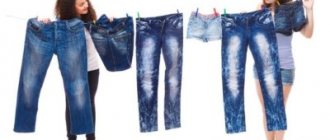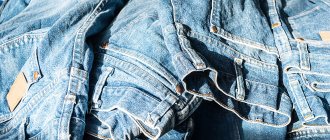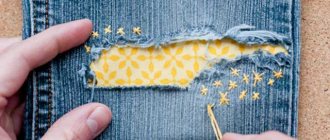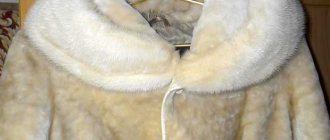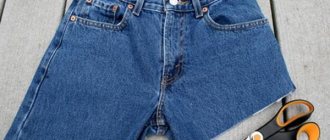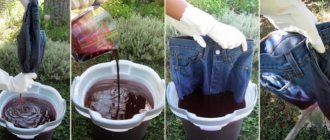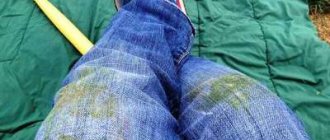Features of denim
Before you start updating your denim wardrobe, carefully study the fabric you will be working with:
- If the item is new and for some reason you decide to modify it with color. Then you can safely dye the fabric in any convenient way, since the weave of the threads is dense and there are no thinned or worn areas yet.
- The item will be reused. In this case, carefully inspect the fabric, marking all abrasions, defects and damage. The lightening process destroys the structure of the threads; in these places the item will be especially prone to tears. Skip these areas when painting. Alternatively, decorate them with additional pieces of fabric, braid, ribbons or threads.
- Pay attention to the denim density. When the material is thin and light, it is more quickly saturated with the coloring composition. The thicker the fabric, the worse the pigmented product penetrates, the more uneven the result will be.
- The abundance of details, pockets, seams, rivets, inserts, flounces and folds make the whitening process difficult. Such textures are good for obtaining stains, patterns and gradients rather than for uniform shade of boiled denim.
Before you start bleaching, carefully examine the fabric you will be working with. Pay attention to the density of the fabric, the presence of details, pockets, folds.
Is it possible to bleach jeans?
Denim differs from other materials in its color instability. It automatically loses color saturation with each wash. The material is paintable. But to get a beautiful result, you will need some skill and knowledge of how to lighten jeans.
To get the desired result, skill and knowledge of the basic rules for lightening denim are important.
The bleaching procedure is suitable for all types and shades of denim. You can whiten the surface of the fabric so that the brightener does not penetrate deep into the structure of the threads. Or you can bleach it in such a way that the fabric in this place becomes thinner and even breaks. This way you can simulate the “flaw” effect.
Using the lightening procedure, you can achieve a “flawed” effect on jeans.
The higher quality the denim, the more aggressive bleaching agents it can withstand. Domestos or long-term digestion are suitable for such material. If you are not sure of the quality of the fabric or it is thin and easily torn, limit yourself to using soda or hydrogen peroxide. These are more gentle options that do not destroy the structure of the threads so much.
High-quality, strong denim can withstand the most aggressive bleaches.
How to do lightening
You can lighten an item in various ways. Classic denim is the ideal base. Its blue, cyan or cornflower blue shades are most susceptible to a uniform loss of color intensity. Be prepared for the fact that the final result is difficult to predict. Each thing will “react” differently.
There is no need to be upset if expectations differ from reality. The fabric can be additionally painted with paints, modified with brightener, or decorated to your taste.
Carefully study all the options for how to whiten jeans. Each method has its own effect. For example, bleach or bleach whitens much stronger and more aggressively than citric acid. In the first case, the shade of the fabric will be lighter and cleaner than in the second.
Before work, test the reaction to the bleach on a small, inconspicuous area of the item. If you are satisfied with the result, proceed with the transformation. If the color is not saturated enough, increase the time the fabric is kept in the solution or change the lightening method.
If you don't get exactly the result you expected, don't be upset. You can always complement the design with paints, accessories or other effects.
If you do not boil the item, but manually create bleached areas, make sure that the bleached spots do not appear on the other side, for example, on the front and back of the trouser leg. Unless, of course, you are pursuing such a goal.
To do this, create separation layers between sections of foil or thick paper. This way, the denim will not be soaked through with the brightening agent and will not create unplanned patterns. In this case, the intermediate layer is removed only after the item has completely dried.
Features of using acrylic products
How do you dye jeans if you want to end up with an original item that no one else will have an analogue? The ideal option is bright and durable acrylic paints that will not fade or fade. They are used for artistic painting - a good option to refresh an item or hide a stain. The use of this type of paint has seven features.
- Preparation. Before starting work, jeans are washed, completely dried and ironed. This will allow the paint to adhere better between the fibers.
- Ease of application. The area on which the drawing will be applied must be placed on a flat surface and secured (for example, with paper clips or double-sided tape).
- Draw the outline. This can be done using a soft pencil or carbon paper.
- Amount of paint. The acrylic layer should be as thin as possible. Otherwise, it may start to peel off.
- The right brushes. To apply a clear pattern, which implies a dense overlap, soft bristles are suitable. For translucent patterns, it is better to use hard brushes.
- Drying. Acrylic paint sets instantly. But it will take at least 15 hours for it to dry completely.
- Recording the result. To ensure that the paint sticks firmly to the jeans, iron the product from the wrong side or through a sheet of paper.
We recommend: How to make soap at home from scratch: what to make, how to prepare, recipes
Despite the fact that acrylic is highly resistant, it is not recommended to expose items painted with such paint to high temperatures. Machine washing and strong rubbing should also be avoided.
Selection of special means
So, you have chosen an item to bleach. There are several ways to quickly lighten:
- The washing machine automatically lightens things by several tones. To do this, add 2-3 tablespoons of pharmaceutical hydrogen peroxide before washing, along with the usual dose of washing powder. The quick and easy method has one drawback: you cannot control all stages of coloring and vary the intensity. The result is unpredictable, but effective.
- Soaking an item in a lightening solution changes the shade by half a tone. This is a gentle method for light, summer fabrics. If the denim material is not bleached enough for your taste, the procedure can be repeated several times until the desired result is achieved.
- Boiling is the most effective way to lighten dense fabrics. The result exceeds all expectations; the material can acquire all shades of white and pale blue. It is necessary to follow the rules of personal safety and spend a little time. And you need special dishes in which food is not cooked.
- The most creative and unpredictable lightening process is done by hand. It is suitable for thin, easily torn items. Using available materials, you can achieve amazing results and bring bold design solutions to life.
The process of bleaching in a washing machine will make it possible to lighten jeans by two or three tones.
But for washing you need to add hydrogen peroxide. When you have decided on a method for bleaching jeans at home, it’s time to familiarize yourself with the variety of methods. Each of them has advantages. And the process is fun and exciting. Sometimes a special product can even be found in the refrigerator. For whitening the following will come to the rescue:
- white;
- hydrogen peroxide;
- lemon or citric acid;
- soda;
- "Domestos" or other cleaning product of similar effect;
- hydroperit.
In order to whiten jeans, many methods and various means are used.
Folk remedies for whitening jeans
Folk remedies for how to lighten jeans at home are equally good in that they are effective with little investment of money and time. This is an ideal option for a spontaneous decision to update things. For example, there is a party planned in the evening or you immediately want a new item in your wardrobe.
Hydrogen peroxide
Hydrogen peroxide can be found in your home medicine cabinet. It is safe to use and creates lightened patterns or streaks with gradient stretching in several tones. The product can be added during washing, then the coloring will be uniform. In addition to whitening, the product eliminates the yellowness of denim that appears over time from long-term storage or constant wear.
Whitening with hydrogen peroxide is one of the most popular and cheapest methods.
Add 3 tablespoons of peroxide to a small bowl of warm water. Adjust the exposure time yourself. Observe the process and soak the jeans until the desired shade is obtained.
You should remember that hydrogen peroxide is highly flammable. Carry out all procedures for updating things away from fire or a switched on stove. Wear safety glasses and do not bend too low over the bowl of solution. If peroxide gets into your eyes, rinse with running water for a quarter of an hour and consult a doctor immediately.
Don't forget about safety precautions when whitening jeans using hydrogen peroxide.
Soda
Baking soda has long been a favorite among home denim designers. You can make your jeans a little lighter at one time, or you can whiten them over and over again, transforming them after each wash.
Before plunging into the basin, turn your jeans inside out. This will help maintain the quality and structure of the threads.
To prepare a soda solution, mix 100 grams of soda and 80 grams of washing powder in a bowl of hot water. Wait for the mixture to cool to room temperature, then place the jeans for an hour and a half.
To preserve the quality and structure of the threads as much as possible, it is recommended to turn the item inside out before immersing it in the basin. Then rinse your jeans in warm water, straighten them to dry, and enjoy the new addition to your wardrobe. This procedure can be repeated regularly, constantly lightening the item by half a tone.
There is a second method of bleaching jeans with soda, which helps to achieve a uniform, beautiful, whitened color:
- Mix baking soda and washing powder in a 1:2 ratio in a bowl of warm water.
- Soak the item in half of this solution for half an hour.
- Wash the jeans by hand by adding the second part of the soda and powder solution to the washing water.
- Rinse the jeans well and dry.
Baking soda will help whiten denim in a few washes.
Domestos
A great way to lighten and bleach your jeans is to use kitchen and plumbing cleaners. This may not only be Domestos. “Toilet duckling”, “Gala” and others are suitable. To create a concentrate for 3 liters of water, use 100 ml of cleaning product. Stir thoroughly and submerge the jeans in the liquid.
There is no recommended time for exposure; you need to control the process of lightening the fabric yourself. Once you are satisfied with the result, the procedure can be completed. Jeans should be washed well and rinsed in running water. If you do not remove the cleaning chemicals from the fibers of the material, there is a risk of an allergic reaction on the skin.
Not only Domestos is suitable for lightening denim. You can use “Toilet duckling”, “Gala” and other means.
White
A strong and effective product can be used in two ways: when washing jeans or boiling them. Whiteness has such a destructive effect on fabric that thin threads can simply dissolve.
Washing is a more gentle procedure for items. This is suitable for light fabrics, for summer, loose denim trousers. To do this, dilute 100 ml of white in a 10-liter bowl of water and stir thoroughly. Immerse the jeans in the solution for half an hour. All that remains is to wash the item with universal powder and dry it.
When covering fabric with “Whiteness” you can use two methods – washing and boiling.
Lemon acid
Citric acid is closer to natural dyes. It does not spoil the quality of the fabric or thin the material, as chemical reagents do. You can discolor jeans with either lemon or citric acid:
- If using lemon, squeeze 10 tablespoons of the juice into a bowl of warm water.
- For the same volume, take 10 teaspoons of citric acid.
- Thoroughly stir lemon or citric acid in water, immerse jeans for 4-5 hours.
- Rinse and dry.
This procedure takes a lot of time. But the quality of the item is preserved, the material does not deform or become thinner.
Bleaching with citric acid takes a long time, but does not spoil the quality of the fabric.
Hydroperite tablets
Hydroperite tablets are comparable to bleaching with hydrogen peroxide. The product lightens jeans by half a tone and protects the fabric structure. Hydroperite is added during washing along with washing powder. This condition is enough to quickly and evenly whiten the item. Crush 3-4 tablets and be sure to rinse the item thoroughly.
Hydroperite is added during washing and lightens the fabric by half a tone. If you need to lighten it more strongly, you will have to wash it several times.
How and with what to dye black jeans
In cases with black jeans, we can only talk about color restoration, so black dyes are needed.
Dyeing black jeans involves restoring and evening out the color
Fabric paint
How to dye black jeans at home? If you don’t like experiments and surprises, buy special fabric dyes .
In ancient times, textile dyes were made from natural materials (minerals and plants), but now most dyes are based on chemicals
Before you dye your jeans black, make sure they are clean and free of stains. Any greasy or dirty stains change the structure of the fibers, and the paint in such places will lie unevenly. Accordingly, the stains must first be removed, and then the trousers must be washed without using conditioner (it may interfere with further staining). Before you dye your jeans, you need to dry them, turn all the pockets and the pants themselves inside out.
Helpful tip: If you're cutting denim to shorten it to your desired length, don't throw away the leftover material. These pieces can be used in the future to test the effect of solvents and dyes if it is necessary to remove stains or dye jeans.
The next stage of preparation is to read the instructions for using the dye and choose a convenient dyeing method. You can dye jeans either manually or using an automatic washing machine. Let's consider each of the methods in detail.
Dyeing in the washing machine
First of all, prepare the paint as indicated in the instructions. Remember that it is better not to pour dry powder into the machine, but to first dilute the dyes (powder and even liquid) in a small amount of hot water to avoid the formation of lumps and clots. The presence of dense fragments will lead to stains on the fabric. If you want to achieve an even and lasting color, strain the paint solution through cheesecloth several times until you obtain a homogeneous mass.
The diluted dye is poured directly into the drum of the washing machine.
We recommend: How to straighten stray down in a washed down jacket
Pour the prepared dye into the drum of the washing machine and add (if the instructions require it) salt, soda or a color fixer, which is sometimes included with the dye itself. Place your jeans inside out and well-stretched in the car. Typically, denim clothing labels indicate a recommended washing temperature of up to 40℃, but this may not be sufficient for dyeing. A better result will be obtained if you choose a mode with a temperature of 90-95 ℃ and a cycle duration of 1.5-2 hours.
Powder and conditioner should not be added to the washing machine when dyeing jeans - the products can ruin the result.
While the jeans are in the machine, prepare a rinsing solution: add 1-2 tbsp to 1 liter of warm water. l. 9% vinegar.
Baking soda and salt are sometimes added to fix the color when dyeing, but 9% table vinegar is rightfully considered the most effective remedy.
After the machine has finished working, the painted items are taken out of the drum and immersed in a vinegar solution for 10-15 minutes. Then the jeans are washed again using the normal cycle (up to 40 ℃) and detergents for colored fabrics. Repeating the cycle will help remove any remaining dye from the fabric and from the machine itself. All that remains is to dry the updated jeans, and also wipe the seals and rubber gaskets of the washing machine with a damp sponge.
Dyeing in the washing machine will not harm the appliance itself, but a small amount of colored water may remain in the drum, which can harm your clothes. To protect yourself from unplanned coloring of light-colored clothes and linen during subsequent washes, run the machine again in idle mode. By the way, it’s a good idea to add citric acid at the same time - at the same time, clean your unit from scale.
Hand dyeing
It's easy to dye jeans by hand.
To dye clothes evenly, you will need a large container that can be placed on the fire and in which you can spread things out as much as possible.
The preliminary steps will be the same as for machine dyeing: the jeans are inspected and, if necessary, washed, and then dried and turned inside out. The paint is diluted and filtered to remove lumps.
In order to dye jeans, it is best to take a large enamel bowl with a volume of 6-10 liters, fill it 2/3 with water and put it on fire. After the water is heated, all the necessary ingredients (paint, soda, salt) are added to it. The solution is mixed well, and the prepared items are immersed in it so that they are completely covered with water. To prevent jeans from floating, they must be periodically submerged under water and turned over using available means. The dyeing process in hot (but not boiling!) water will take 40-60 minutes. In this case, it is advisable to cover the container with a lid so that less chemicals evaporate into the air, and ventilation should be provided in the room.
After boiling, the jeans should be rinsed first in warm water and then in cold running water. To fix the color, they are also soaked for 10-15 minutes in a weak solution of 9% vinegar (1-2 tbsp per 1 liter of water).
After soaking in a vinegar solution, the jeans are washed using regular soaps.
The big advantage of hand dyeing is that you can control the entire process and be creative. Various options for twisting, pinching, and creasing the fabric can give a unique result in the form of unusual patterns or ornaments, color spots and stains, or the popular “varenka” effect on jeans.
Alternative Dyes for Black Jeans
If for some reason you are not satisfied with ready-made textile dyes, there are other options. True, they are all very controversial and more expensive.
Hair dye
In order to dye jeans black, you will need black hair dye, preferably without ammonia and with natural pigments.
The paint must be chosen in a pure black color - without additional tints or shades
To dye one pair of jeans, you will need two packages of hair dye. The dye is diluted in a small volume of water (it should be enough to completely immerse the fabric) without oxidizing agents or other additives. Mix the water and dye well to make the solution homogeneous, place the jeans in it and leave for 1-1.5 hours. To achieve uniform dyeing, the fabric needs to be pressed and turned from time to time.
When working with dye, be sure to wear gloves.
After soaking in the dye mixture, the items should be rinsed and immersed in the vinegar solution for another 15-20 minutes. To better fix the color, it is recommended to add table salt to the vinegar at the rate of 1 tbsp. l. for 1 liter of water. It is important to understand that such dyeing will not be permanent, and the jeans will fade with each subsequent wash.
Ink from felt-tip pens
To paint jeans, it is recommended to take several black felt-tip pens, take them apart, and dip the ink rods into cool water. When the water turns black, jeans are immersed in it and kept for at least 1 hour.
Aerosol and acrylic paints
They are used not exactly for coloring, but rather for decorating your favorite things.
Using acrylic or aerosol paints, you can paint any patterns and ornaments on fabric.
Aerosol paints are simply sprayed over the surface of laid out jeans, while acrylic paints are applied using brushes or the edge of a sponge. At the same time, it is almost impossible to achieve uniform coloring, but you can safely create, showing all your imagination. Interesting results can be obtained if you use stencils. After painting, acrylic is fixed to the fabric, ironed with a hot iron, laying layers of white paper on top and bottom of the jeans.
Lightening process
The dynamics of fabric lightening directly depends on how well it was saturated with the bleaching solution and how long this process lasted. If you regulate the access of reagents to certain areas of the tissue, you can obtain original patterns and stains.
Slight brightening effect
You can create partial lightening on an item without completely immersing it in liquid with bleach. For example, you plan to lighten the bottom of your skirt and get an ombre effect. Immerse the product in the diluted composition to the painting height. In order not to keep the item hanging, secure it on a stick or on a hanger. This way you will get a uniform blurred edge using the ombre technique.
The longer you leave the item in the solution, the more the colors will fade. Adjust the intensity of the dyeing process and remember that dried fabric will look lighter than wet fabric.
The effect of lightened stains
Beautiful lightened stains are obtained if you first twist the jeans tightly and secure them in this position with elastic bands. The bleaching liquid will penetrate unevenly into the structure of the fabric and will brighten the areas of the fabric that are “outside” more strongly. The material inside the resulting folds will be least susceptible to staining.
After washing and drying, beautiful horizontal stains with smooth, blurred boundaries are obtained on the fabric. To whiten vertical stripes, securely hold the jeans in certain areas with clothespins or paper clips.
Bleaching threads on pants
If you have jeans with a ripped effect and multiple horizontal threads, you can only dye them. It will look original and attract the attention of others. To prevent the fabric from staining on the back side of the item, place a protective layer of foil or other dense material inside the item. Blot the threads with bleach, leave for the required period of time, rinse and dry.
On torn pants, only horizontal threads can be lightened. It will turn out original and impressive.
Complete whitening
To achieve complete bleaching, maximum lightening of the item, boiling or very long soaking will help. The stronger the effect of the coloring composition, the more the structure of the thread is destroyed. The lighter the item, the easier it is to achieve maximum lightness.
You can get strong whitening results by boiling or soaking for a long time.
Fringe bleaching
It is better to bleach individual threads, such as fringe, by hand. This makes it more convenient to control the color change process. Cover the areas you don't plan to paint with tape. Blot the threads with the prepared solution using a kitchen sponge. Or spray from a spray bottle.
When the threads change color to the desired color, rinse the area of fabric in cool water, peel off the tape and dry.
It is better to bleach fringe on jeans or denim shorts by hand.
Creating drawings or patterns
Beautiful patterns are created using improvised means:
- If the fabric is pinched with clothespins or bobby pins before bleaching, the result is pointed stars.
- For blurry circles, pull part of the fabric with rubber bands or strong threads.
- Citric acid and stencils create original patterns on fabric, even if you don’t know how to draw professionally.
- A spray bottle or sprinkler will create beautiful drops, drips and splashes.
If you decide to decorate your jeans with patterns, you can get an excellent result using a stencil and citric acid.
Partial whitening
When there is no goal to completely change the color of denim, but you still want to refresh the appearance of your favorite trousers, you should use some tricks and give free rein to your imagination. Creativity is always welcome, which is also true in clothing design. The main thing is to know when to stop. Partial whitening of jeans is possible in several ways.
Patterns and drawings
Using a stencil and a bleach solution, a simple pattern is created, for example, stripes, polka dots, hearts.
What you will need:
- finished stencil;
- dense backing for fabric of a suitable size;
- sponge;
- gloves;
- solution based on peroxide or chlorine.
How to use:
- It is better to outline the location of the future pattern in advance;
- A backing is placed inside the trouser leg to prevent the solution from leaking;
- the sponge is soaked in bleach and applied to the desired area using a stencil;
- the duration of action of the solution depends on its concentration and the desired intensity of the pattern;
- The trousers are rinsed in clean water and dried.
Gradient
An interesting effect is obtained if the trousers are consistently kept in bleach with boiling water. The jeans are suspended above the container and lowered in a vertical position to the desired transition level. By gradually lifting the trousers out of the solution at regular intervals, you can get the effect of transitioning from blue to light blue to white.
Whitening areas of the product
This method is similar to applying stencil designs, only in this case there are no frames, only imagination!
Using a free-form sponge, apply the bleach to the desired areas. For example, to simulate abrasions, the liquid is distributed in smooth movements along the trouser leg from top to bottom.
Tip: for a visual effect of volume, highlight areas on the hips and buttocks.
To achieve the popular tie-dye effect, the item is tied into a tight knot and placed in a solution with bleach. This method of soaking helps to achieve an unusual visual effect in the form of contrasting blurry spots. Their distribution throughout the fabric directly depends on how the knot was tied.
How to boil jeans
The process of boiling in white is the most labor-intensive, but effective:
- Wear rubber gloves and, if possible, safety glasses.
- Use a metal bucket or pan.
- For occasional stirring, use a wooden stick or spatula.
- Fill the container halfway with water so that the boiling liquid does not spill out or splash.
- Immerse clean and dry jeans in the boiling solution.
- Make sure that the item does not float during bleaching.
- The first fabric lightening effect will appear within 10 minutes.
- It is recommended to “cook” jeans for no more than half an hour, otherwise the whiteness will begin to destroy the structure of the threads.
- After boiling, wash and rinse the jeans well.
- The final result of digestion will be visible on the dried fabric.
When boiling denim, you can get an unexpected and very original result.
Acrylic paints
You can paint jeans with acrylic paints at home. They do not wash off and are very durable. Apply to the product with a brush, drawing the selected design.
Painting jeans with acrylic:
- Wash the item, dry it and iron it well.
- Smooth or stretch the area where you will apply the paint.
- Place cardboard in the pant leg to avoid staining the back side.
- The paint is applied in a thin layer so that the design lasts longer. You can buy stencils or make them yourself, this makes it easier to apply the product.
- After finishing painting, you must leave the product in its original condition so that it dries well. This will take 15 hours.
It is not advisable to machine wash decorated jeans. In order for the product to preserve the design longer, it must be washed at a temperature of 30–40 C, by hand.
How not to spoil something
- Always test the bleach liquid on a small area of the fabric. Evaluate the result, check the quality of the threads after dyeing.
- If you are creating original patterns, do not use metal clamps to avoid rust stains.
- Do not exceed the permissible concentration of whiteness and the time the fabric remains in the solution. This destroys the fibers of the fabric, and there is a risk of ruining the item forever.
- If you use a lace to tie fabric, take a white one so that it does not bleed its dye onto your jeans.
- Do not boil items made from thin stretch fabric.
- Follow safety precautions! Remember, you are working with liquids that can cause injury and burns.
The whitening process is fascinating and gives free rein to your imagination. An ordinary, boring, boring thing can sparkle with new colors. It’s especially nice that whitening is inexpensive and easy to perform. Update to your heart's content!
Blue
Blue is the most affordable product suitable for all types of fabric. It is harmless to the skin and easy to use.
You can buy Blue at a hardware store. It is produced in powder and concentrated liquid.
How to dye your jeans yourself:
- Wash the item from stains and other contaminants before the procedure, rinse thoroughly from the powder until clear water.
- Dilute Blue in 3-4 liters of warm water. Temperature: 30–35C. There should be no clots.
- Fill the bath with the required amount of water and pour in the blue, add 2 tbsp. l. table salt.
- Place the item in the bathroom in a dye so that there are no wrinkles. This way the jeans will be dyed evenly.
- After 2 hours, the items are rinsed in plenty of cold water. To consolidate the result, wash the jeans in a vinegar solution. The blue color will become more saturated and lasting.
Dry the fabric in a straightened state so that the color on the folds and creases does not change.

